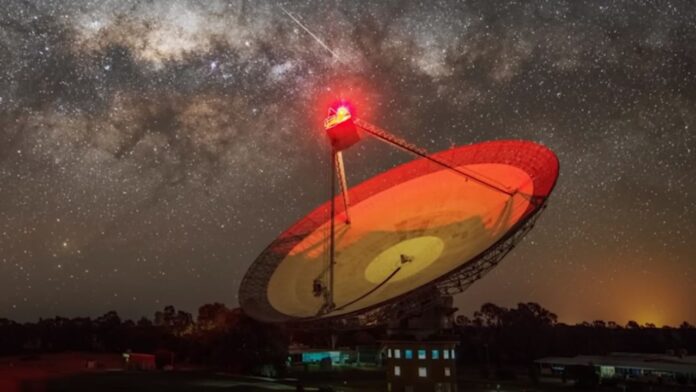Astronomers have observed an extraordinarily distant and powerful fast radio burst (FRB) that released a massive burst of energy in a fraction of a second.
FRBs are intense, millisecond-long radio wave flashes with unknown cosmic origins. Since the first detection in 2007, hundreds have been spotted flickering from distant points in space.
Read More: Webb Telescope Detects Stunning Quartz Clouds on Exoplanet
This newly discovered FRB unleashed energy equivalent to our sun’s total emissions over 30 years – all within a millisecond flash. Catching these momentary outbursts presents challenges requiring precise sky scans.
An array of radio telescopes in Australia called ASKAP detected this FRB in June 2022 and pinpointed its origin location. Follow-up observations then traced its source galaxy.
The host galaxy appears to be merging with one or two others, spurring star formation. This supports theories that FRBs may originate from energetic aftermaths of stellar explosions.
Read Also: SpaceX Psyche Rocket Metal Asteroid Mission
Traveling 8 billion light-years, this is the most distant FRB with a known host galaxy. This immense distance provides valuable insights into the universe’s missing matter between galaxies.
FRBs can “weigh” this hard-to-detect cosmic material through it subtly altering the bursts’ radio wavelengths. More distant FRBs reveal more diffuse matter.
Understanding these brief, brilliant radio beacons offers promises from mapping universal structures to solving mysteries about astronomical distances and physics.
Astronomers expect thousands more FRBs will be found by future radio telescopes under construction, dramatically expanding this strange cosmic phenomenon’s power as a tool for discovery.


















![10 Countries With the Best Healthcare in the World [Statistical Analysis] Countries With the Best Healthcare in the World](https://articleify.com/wp-content/uploads/2025/07/Countries-With-the-Best-Healthcare-in-the-World-1-150x150.jpg)










